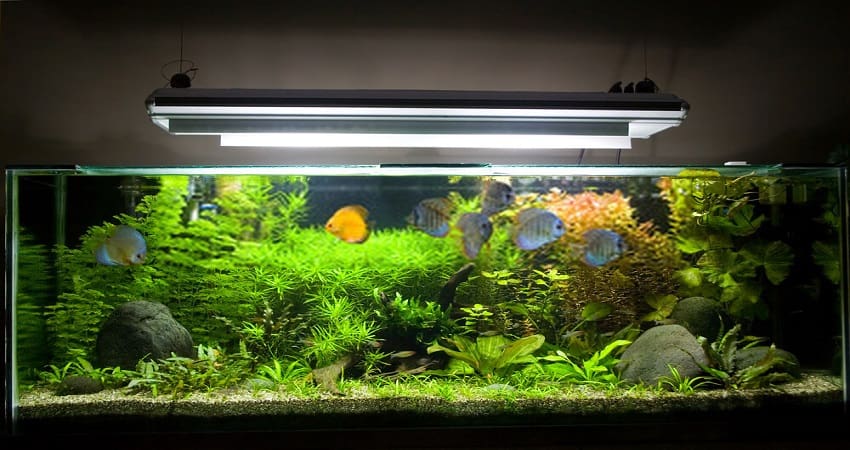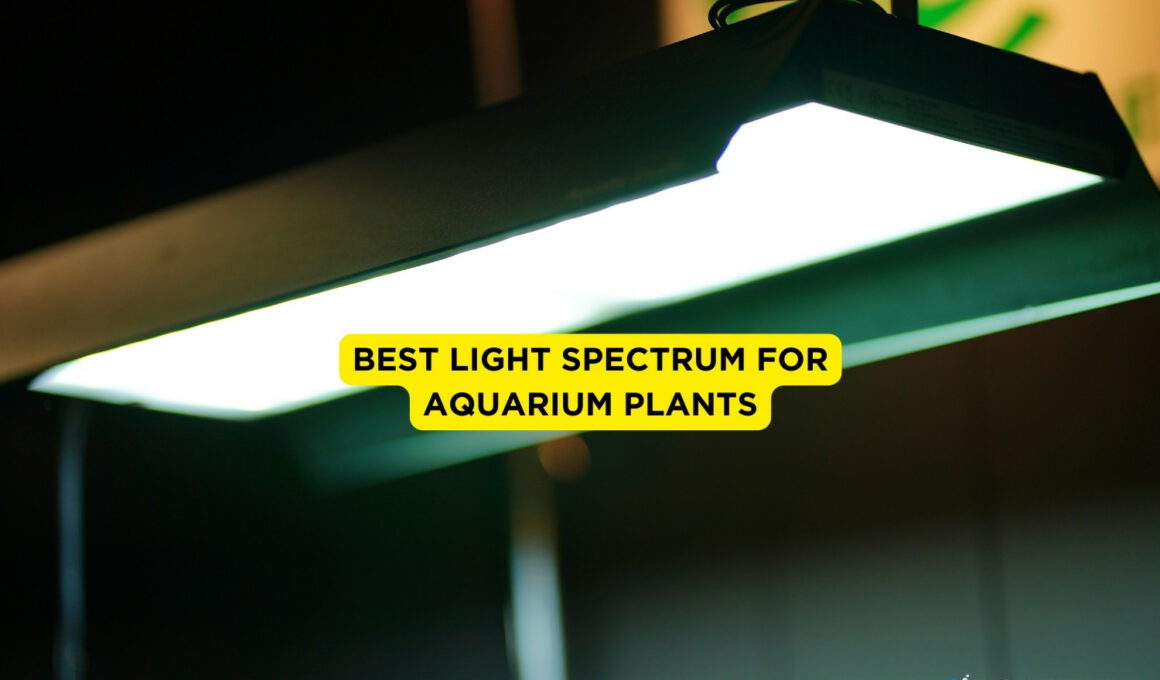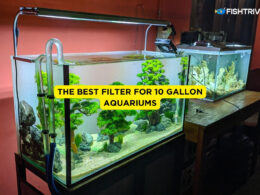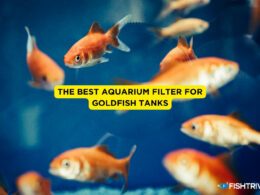In this article Show
Understanding the best light spectrum for aquarium plants is essential for any aquarist starting your first tank or refining an established underwater garden. It’s a key part to making sure your pets are well and living their best life. If you’re looking for the best aquarium lights for your tank, I’ll first recommend the Fluval Plant Spectrum Light; it’s everyone’s go-to option and pretty much the most popular on the market right now. Testing shows it outperforms other light spectrums in its category by far, but don’t take our word for it, here are the other lights tested as well and how they hold up;
Best Light Spectrum for Aquarium Plants
Light, in its diverse spectrum, plays a fundamental role in the health and growth of aquarium plants. Different wavelengths of light, from the blues to the reds, have distinct effects on your aquatic plants, influencing everything from photosynthesis to growth patterns.
But what exactly is this light spectrum, and why does it matter so much for your underwater flora? This guide’ll explore these questions, providing you with practical insights and scientifically-backed information.
Also worth reading;
- How To Grow Cabomba Aquarium Plant: Complete Guide
- How To Grow Hornwort Aquarium Plant: Care Guide
- How to Plant Water Lily Bulbs in an Aquarium
- How To Clean Plastic Aquarium Plants: Complete Guide
- The Best Floating Aquarium Plants For Fry, Shrimp, and Betta
Ideal Light Spectrum for Aquarium Plants
Much like their terrestrial cousins, aquarium plants rely heavily on photosynthesis for growth and health. This process is intricately linked to the light spectrum they receive. The ideal light spectrum for aquarium plants falls primarily within two key ranges: blue (400-500 nm) and red (600-700 nm).
The blue light promotes robust leaf growth and strong stems, while red light is crucial for flowering and overall health.
- Blue Light (400-500 nm): Essential for encouraging lush foliage, blue light helps in the development of strong plant structures.
- Red Light (600-700 nm): Promotes flowering in plants and is vital for their overall health and vitality.
It’s a balancing act. Too much of one and not enough of the other can lead to suboptimal growth or even plant stress. The goal is to mimic natural sunlight as closely as possible, which leads us to the next point: choosing between full-spectrum and targeted spectrum lights.
Full-Spectrum Lights vs. Targeted Spectrum Lights
Full-Spectrum Lights
These lights are designed to simulate natural sunlight, providing a balanced blend of all the colors in the light spectrum. They are generally preferred for their ability to create a natural-looking and aesthetically pleasing aquarium environment while meeting the needs of most plants.
Targeted Spectrum Lights
These lights allow you to adjust specific wavelengths, focusing on the spectrum’s blue or red ends. They are ideal for specialized plant care, where certain plants may require more of one type of light than the other.
Types of Aquarium Lights Available
Here are some of the types of aquarium lights you can get today.
- LED Lights: Modern, energy-efficient, and long-lasting, LED lights are a popular choice for aquarium enthusiasts. They often come with options to adjust light intensity and spectrum.
- Fluorescent Lights: These are the traditional choice for aquarium lighting. They offer good spectrum coverage but are less energy-efficient compared to LEDs.
- Halogen and Incandescent Lights: Less common, these types can produce a lot of heat and are not as energy-efficient. They are typically not recommended for planted tanks.
Pros and Cons Concerning the Light Spectrum
LED Lights
- Pros: Energy-efficient, long lifespan, customizable spectrum and intensity.
- Cons: Can be more expensive upfront, spectrum quality varies across different brands.
Fluorescent Lights
- Pros: Generally cheaper, good for standard setups, decent spectrum coverage.
- Cons: Less energy-efficient, shorter lifespan, limited customization.
Halogen and Incandescent Lights
- Pros: Strong light output, can be inexpensive.
- Cons: High energy consumption, significant heat output, poor spectrum for plant growth.

Best Light Spectrum for Aquarium Plants
The following are the best light spectrums for aquarium plants;
1. Fluval Plant Spectrum Light
Fluval is famous for producing high-quality, low-cost aquatic products such as filtration systems, fish ponds, and lighting fixtures. The Aquasky LED helps you personalize your lighting system by mixing super-bright white LEDs with the necessary red, blue, and green tri-colored lights for optimum plant growth.
There are also several gimmicky possibilities to mess with, such as disappearing lunar, lightning, cloud cover, and stormy weather.
The Skypad infrared remote control helps you change the sky and color effects from your armchair’s safety. Lensed LEDs have 120o light dispersion for excellent aquarium coverage and lighting uniformity.
Key Features
- 25-watt power
- 32”-40” length
- 6500K white LEDs
- Tri-colored RGB LEDs
- Customizable lighting options
- 120-degree light dispersion.
2. Current USA Satellite And Professional Plants Light
The current USA built their fixture to be as unobtrusive as possible, but it had the opposite effect. It’s anything but unimpressive! The head unit is slightly thicker than a 1/2′′ (12.5 mm) and has a streamlined, minimal build.
It employs Radio Frequency, which is susceptible to being deflected by electronics. The cord length is an essential aspect of all aquarium lighting that is often ignored. Hobbyists are constantly hoping for enough duration to attach to the surge protector.
Prices for Current USA’s Satellite Freshwater LED Plus are also not bad.
Key Features
- 4 Color Spectrum Adjustment RGB+W
- 6 Color Presets
- 4 Custom Color Memory Settings
- 12 On-Demand Weather Effects.
3. Critical ClassicLED Lights – Perfect For Low-light Tanks On A Budget
This isn’t shocking, given that many beginners prefer a low-risk, low-light planted tank, which this LED lighting fixture is ideal for. Since the manufacturers removed any needless bells and whistles, it’s a budget-friendly choice.
The PUR and PAS are also adequate, as they can support various low-light live aquatic plants. By the way, the spectrum makes your colorful fish pop. In any case, you’ll save money on both the initial cost and the subsequent energy use.
You’ll get minimal light spread and shadowing in the corners if you buy the shorter fixture and expand it to match a more giant planted aquarium. Since the lids don’t match very well, you must be very careful when opening them. You’ll be fine as long as you don’t unintentionally push them or something.
Key Features
- Material: Glass Tube, Plastic protection caps, Rubber suction cups.
- Quantity of LED: 18pcs LED Color of the Light: White Light
- Length of Light Bar(including protection caps): 18~20cm (7.5 inches)
- Diameter: 18mm(Glass Tube), 27mm(Protection Cap)
- Power Input: 100V-240V 50Hz/60Hz
- Cable Length: about 115cm (Plug to Adaptor) + 115cm(adaptor to LED bar) approx.
4. Beamswork DA FSPEC 0.50W Pent
Beamswork’s DA FSPEC 0.50W Pent is a slightly improved version of the EA FSPEC. The Pent would finally work for a high-tech breeder-planted tank of 10, 15, 20, or 30 gallons. Tanks with a height of 12 inches. This LED light will help aquarium plants that need a lot of light to grow, which is excellent, given its low price.
The daylight range enhances the colors of both fish and aquarium plants, giving your planted tank a very appealing hue. When designing my tanks on a budget. The drawbacks are that the LEDs do not have flawless beam blending. You would find a slightly disco-colored bottom if your filter or aerator overexcited the water surface.
Aside from that, the BeamsWork DA FSPEC Pent is a low-cost LED light that can grow live aquarium plants in a shallow tank. If your plans for a planted aquascape suit this definition, then go ahead and buy either one.
Key Features
- Lumen: 3100
- LEDs: 60x 0.50W
- Config: 42x 10000K, 8x Actinic 460nm, 5x Red 620nm, 5x Green 520nm
- Timer Ready, 2 Mode Day / Night
- Suitable for freshwater, plants, cichlids.
Frequently Asked Questions
How bright should aquarium lights be?
If you only use “Simple” plants, 10-20 lumens (0.25 to 0.5 watts) per liter is appropriate. We suggest 20-40 lumens (0.5 to 1 watt) per liter for “Medium” plants and more than 40 lumens (1 watt) per liter for “Advanced” plants.
Is LED light bad for aquarium fish?
Driven lights are healthy for fish. LED lights are also safe to use in freshwater aquariums of live plants. Aquarium lighting can be activated for 8 to 12 hours a day.
Will regular LED lights grow plants?
In general, indeed. However, since LED technology is so versatile, each bulb is unique. You want bulbs that emit the same combination of red, blue, and other wavelengths that your plants want.















